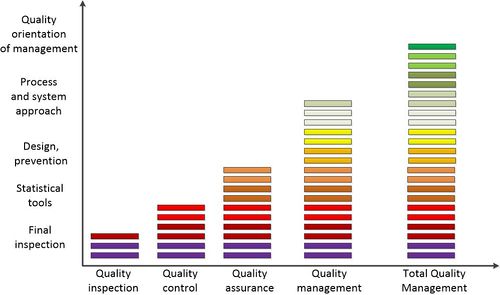Quality inspection
| Quality inspection |
|---|
| See also |
Quality inspection are measures aimed at checking, measuring, or testing of one or more product characteristics and to relate the results to the requirements to confirm compliance. This task is usually performed by specialized personnel and does not fall within the responsibility of production workers. Products that don't comply with the specifications are rejected or returned to improve.
Origins of quality inspection
Quality inspection is the first stage of evolution of quality approach (see figure 1). The origins of the quality inspection back to the late nineteenth and early twentieth century. In days of fast-growing industry, Frederick Winslow Taylor developed the rules of scientific management. Quality wasn't up to speed with rapidly increasing labour productivity. Often, the customer had to reckon with defective products. To alleviate customer frustration, this problem was solved by replacing the defective product with a new one. Conducting this type of procedure entailed generating considerable cost. To reduce the excessive cost escalation manufacturers introduced controller position, unknown to craft. The designated employee, through carried out inspections, made sure that the greatest possible number of good products leave the gate of the factory. This initial form of quality inspection based on the principle of quality by sorting.
The scope of quality inspection
Organization which uses quality inspection, treats inspector as if he was a customer. The optimum form of quality inspection is the man who's aim is the best customer satisfaction. Quality inspection serves three main purposes:
- Identification of the quality problem
- Provision of information to managers
- Elimination of the problem by managers
Quality inspection can be performed at the end of production process (final inspection) or at several stages of the production (intermediate inspection).
Quality inspection vs. quality control
Quality inspection is concerned on postoperative or post-production check of products. It doesn't have direct impact on production process. Quality inspector only sorts products, and he doesn't let poor quality products to leave the factory. Quality inspection has no feedback loop. That means that information about failures and their causes is not passed to workers or managers. Therefore, this system cannot improve itself.
Quality control is the next stage of quality approach evolution. In that approach there is a direct connection between quality inspector and workers. Tests should not only distinguish bad products from good, but also find the cause of problems. This information should be sent to managers, as well as workers, who can then improve the process. The sub-stage of quality control is statistical quality control, known also as statistical process control. Quality control is a one feedback loop system. Information is passed to workers, who can try to improve their work, but not to change system or product.
See comparison between quality control and quality assurance in article about Quality control.
Sample size
See: sampling for more information. Due to improvement of statistical methods 100% sample is not necessary, and it never have been efficient. In practice errors made by quality inspectors lead to sending low quality products to customers. The most efficient way is quality self-assessment and protective actions. In fact, many scholars and managers point that quality inspection does not create value to the customer (e.g. Genichi Taguchi).
- Inspection one hundred percent - consists of subjecting the inspection of all units produced. Due to time-consuming, this method is applied only to products manufactured individually or in small series. It was typical for phase of quality inspection
- Statistical inspection - a lot of statistical inspection is assessed on the basis taken in a random sample. Therefore, this form of control is called a sample inspection. Depending on the size and frequency of sampling and the use of audit information to reverse effects on the production process, inspection may be statistical in nature. This method was typical in early phase of quality control.
- Statistical process control (SPC) is an idea created by Walter A. Shewhart who created methodology for using statistics to detect potential errors before they happen. Thanks to Shewhart's control charts managers can predict errors based on information about production process malfunctions. This method was popularized in phase of quality control and is used in quality assurance and quality management approaches.
References
- Boukouvalas, C., De Natale, F., De Toni, G., Kittler, J., Marik, R., Mirmehdi, M.,... & Vernazza, F. (1997, May). An integrated system for quality inspection of tiles. In Int. Conference on Quality Control by Artificial Vision, QCAV (Vol. 97, p. 49-54).
- Lieberman GJ (1965), Statistical Process Control and The Impact of Automatic Process Control, Technometrics, Volume 7, Issue 3
- Taguchi, G. (1986). Introduction to quality engineering: designing quality into products and processes
- Taylor HM, Statistical Control of a Gaussian Process, Technometrics, Volume 9, Issue 1
- Unal, R., & Dean, E. B. (1990). Taguchi approach to design optimization for quality and cost: an overview.
- Myth of added value of inspection @ wawak.pl.
Author: Slawomir Wawak
